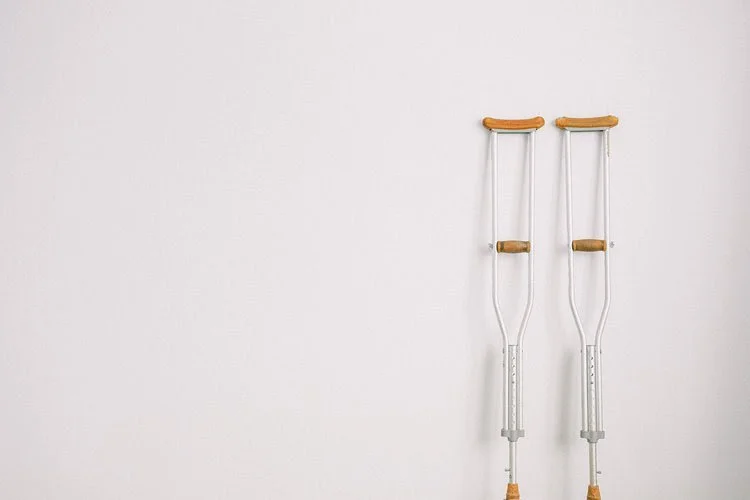Get Rid Of Your Crutch - Issue 78 - 10th September 2023
You may have noticed that I enjoy using metaphors. I find that metaphors, symbols and imagery help make complex or fundemental ideas easier to digest and easier to apply to my life. One such image that I have recently come to apply to my life is that of a crutch. A crutch is used to take the weight off of a leg or foot so that it can heal. The beauty of a crutch is that it allows gradual pressure to be put on the injured leg ensuring that it heals effectively. If the crutch was used or relied on too much, the injured leg would whither and become weak. If the crutch wasn’t used at all and you attempted to walk normally whilst the leg is still injured, it would only exacerbate the problem.
When an individual is healthy in body and mind and generally fulfilled, they will not become addicts, even after injecting heroin
Just as crutches are used to heal physical ailments, they are also used to heal mental ailments. Of course I don’t mean physical crutches here but metaphorical ones. We also, to some extent, have crutches that we lean on so that we don’t injure ourselves mentally. Some crutches are healthy such as relaxing after a productive or difficult day, cheat days once a week in which any food is allowed or a holiday after a productive or difficult few months (as I am doing now). Some crutches are unhealthy such as sitting on the couch or in bed all day and every day, eating junk food every day or addictions. Addictions are the result of a mental crutch being used to soothe negative feelings or to suppress traumatic experiences. Addictions should not be viewed as a shameful formulation but rather an imperfect response from our brains that had the best of intentions. Addictions are formed to shield us from pain, they just become unhealthy when relied on. Addictions are also only formed from pain. When an individual is healthy in body and mind and generally fulfilled, they will not become addicts, even after injecting heroin, they do not need crutches because they are not injured. This was a startling discovery by Dr Bruce Alexander. Experimenters before Alexander knew that by placing a rat in a cage with two bottles, one with water and the other with water and heroin or cocaine, the rat would choose the drug infused bottle rather than plain water and consume it until they died. Alexander however questioned whether this result was due to the drug itself or the conditions in which the rats were placed. He then repeated the experiment but with one small change: he placed the rats in what he called ‘rat parks’ where they were amongst other rats, free to roam and play. He then placed two bottles inside, one with water and one with drug-laced water. The rats overwhelmingly preferred the plain water over the drug-laced water even after trying the drug-laced water (2).
This experiment proved that drugs like cocaine and heroin are not innately addictive but they are if the individual consuming them is in pain, is suffering or has suffered in the past. Everything that has the potential for addiction can be thought of as crutches. A mentally injured person requires a crutch in order to live and they then rely on this crutch and it becomes increasingly difficult to walk without it. This way of viewing our unwanted habits, even if they aren’t necessarily addictions, can be useful as it grants a certain degree of empathy towards oneself, as your brain has simply created a crutch in order to heal but it has the potential to do the opposite. Therefore, first it’s helpful to acknowledge and identify any crutch(s) you may be using now, then acknowledging and identifying the injury. This can be done by first identifying when you use this crutch; What were you doing directly before using it? When do you tend to use it? What purpose does the crutch serve? Will this crutch encourage healing and growth or the opposite? If it’s the latter it may be worth putting gradual and incremental pressure on your mental injury in order to heal and grow. This can be done with slowly reducing your use of the crutch, with diving deep into the injury itself either by writing your thoughts and emotions regarding the injury or by speaking with someone about it. As much as this will be painful or shameful or a struggle, it will alleviate the pain long-term, put pressure on the injury enough to allow healing and eventually allow you to stop using your crutch and walk with both feet.
Keep On Struggling,
Gregor
TV Show I’m Loving - The Bear
“A young chef from the fine dining world returns to Chicago to run his family's sandwich shop (3)”.
I have just finished the first season of this and I love it. The writing is slick, the references to the world of restaurants and cookery are subtle but effective and it’s an easy watch after a long day. It’s available on Disney+.
Quote to Ponder
There's no such thing as a creative type. As if creative people can just show up and make stuff up. As if it were that easy. I think people need to be reminded that creativity is a verb. A very time consuming verb. It's about taking an idea in your head and transforming that idea into something real. And that's always going to be a long and difficult process. If you're doing it right, it's going to feel like work - Milton Glaser
References
1) Image Credit - RawPixel & Pexels
2) https://www.psychiatrictimes.com/view/what-does-rat-park-teach-us-about-addiction#
3) IMDB
4) The Bear Image - IMDB



